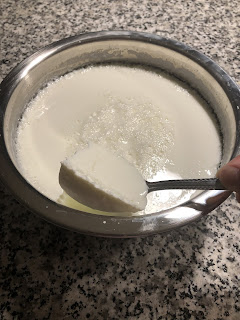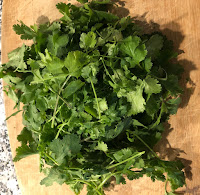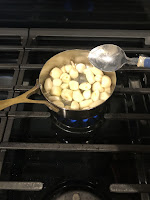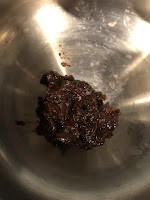Usually curd is stored in a red stone pot or matka pots to prevent sourness. I don’t have one. So i am storing it in a stainless steel vessel.
This recipe/technique simply focuses on home made curd made from fresh whole milk using the home made curd culture. There are so many blogs and articles focusing on cheese curd, and variety of yogurts which i am not going to deal with right now (in this post). I always prefer to store a cup of my culture and ensure i never run out of it. That’s an important fridge-treasure for me. If i am going on a vacation to India for more than a couple of weeks, then i will ask one of my friend here in Tulsa, OK. Her age is close to my mom’s and she is a wonderful cook. When i moved here in 2016, I was 7 months pregnant. She used to give me whatever she cooks. She invites us to her group’s potlucks and that’s how we came to know so many people in Tulsa. A wonderful place to thank her for everything. Her entire family has always been kind to us. Thanks a lot Brinda aunty and Venkatesh uncle. Residing in a place so many miles away from your hometown, friends and neighbors helping us without asking for, is truly a blessing. When i write this, my heart is full of gratitude and thankfulness. I have so many people to thank and definitely a single post would not be sufficient to do that. As I already mentioned, I will be sharing each and every memory associated with a dish appropriately. So coming back to the curd technique, it’s very important to have a home made perfect curd culture. I don’t trust store bought curd and I won’t use that as a culture because that will never give a perfect, non sticky curd. I also read so many posts on making curd without culture, or using lemon etc... PLEASE ... A big NO !! So get a proper culture from whom you trust and then proceed.
Reason to chose this recipe or i will call it as a technique again , is today is my dad’s 60th birthday. And he is a big thayir fan. Be it idli, dosa , chapathi, upma, poori , anything and everything, the finishing point is curd for him. Before he washes his plate, definitely it will be white in color. Without curd, he can’t survive. My mom never runs out of curd. Everyday she makes curd out of a half liter milk packet. We have to stop serving it. He will never say “போதும்”. So much love he has for curd and so much love and respect i have towards him, made me write this today, on his birthday. My parents would have been here with us now, but due to COVID-19, their trip and the planned simple sastiabthapoorthy (60th marriage) got cancelled. Anyway, I wish him many many happy returns of the day and praying many many more to come. “Happy 60th birthday Appa. Love you so much.”
Lets move on to the technique.
Preparation Time : 5 minutes
Cooking time. : 10 minutes
Fermentation Time : anywhere between 3 hrs and 7hrs
Ingredients:
Whole milk (full fat) - 2 litres
Home made curd culture - 4tbsp
In a saucepan ( i prefer a ceramic or a heavy bottomed stainless steel pan), add the whole milk . Boil it.
Keep stirring it every 3 to 4 minutes to ensure the milk doesn’t get burnt at the bottom. The flame should be in medium - high.
Once it comes to a good boil, turn off the stove and transfer it to another container. I am attaching a video to clearly give a picture as to when the pan needs to be removed from the stove.
Once the milk becomes warm ( it should not be hot and it should not be luke warm, anywhere between these two) , add the culture and mix it. See the hot air that is coming above from the milk. That means the milk still needs to cool down. Those fumes should stop.
Once the milk becomes warm, add the culture and mix it. Give a good mix. The lumps in the curd culture should break and gets mixed with the milk.
Leave it undisturbed for 4 hours to 6 hours. Check after 6 hours. If it’s set, keep it inside the refrigerator.
Enjoy the freshness of thick, non sticky home made curd. These are little pleasures of life that gives immense happiness and pride.
Important Tips :
1) For a beginner, it’s hard to find out at which stage the curd needs to be mixed, so use a spoon and test the temperature of the milk. Check whether its warm (less than hot and more than luke warm). I used to touch the vessel, decide when to add the culture based on the warmth of the vessel. That takes quite sometime. Until you reach that, please follow the beginner’s tip.
2) People living in colder regions - mix the curd in a slightly hot temperature ie., immediately after the fumes stop. Fermentation occurs quickly. Whereas people in India, add it during the luke warm stage. The curd will be set in just 3 hours because of the weather.
3) Trust me, the curd sets in just 3 to 4 hours for me. I will leave it in my countertop. I won’t keep it inside the oven or warmer. Even during winter, i follow the same. That happens once you start making curd frequently. Personally, i feel keeping it inside the oven or any other artificial methods (like adding milk powder or instant pot) alter the taste. I have tried instant pot method to prepare yogurt. I did not like it personally and it consumes electricity.
4) Please do not use microwave to boil the milk. Please use the cooktop to boil it.
5) Try to set the curd during the morning. It gets set in 5 to 6 hours and you can refrigerate it as soon as it gets set. If you do it in the night , you might have to leave it for a longer time and the curd becomes sour in taste (my personal experience).
Please feel free to post questions if you have, in the comment section. I am always happy to help. !!!




















































